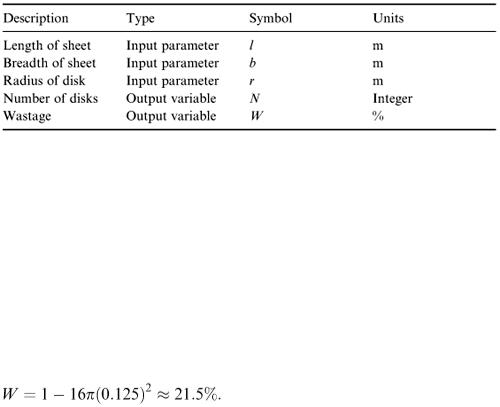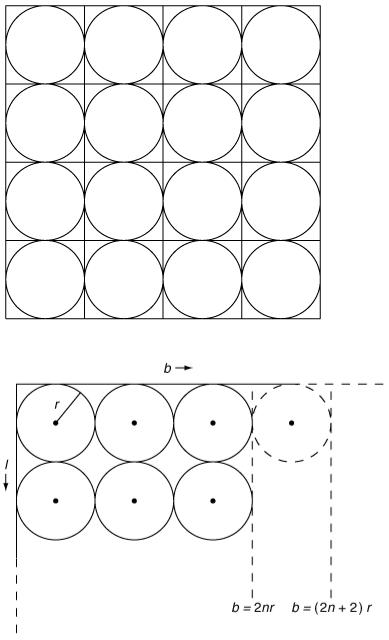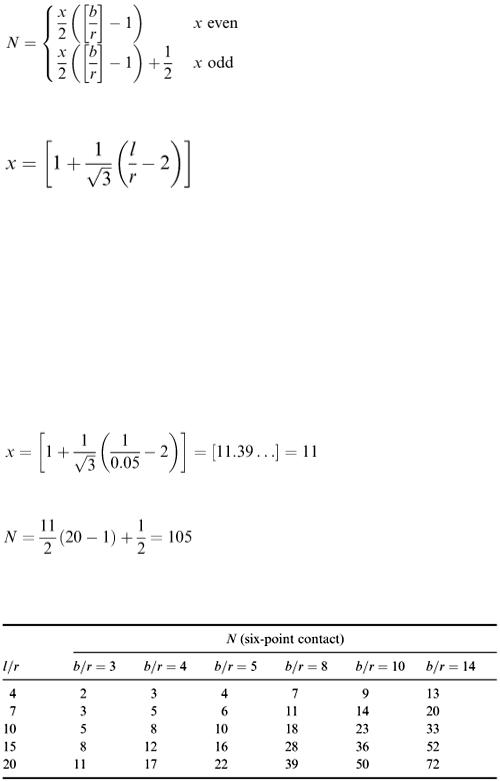
- •Preface
- •1.1 Introduction
- •1.2 Models and modelling
- •1.3 The learning process for mathematical modelling
- •Summary
- •Aims and objectives
- •2.1 Introduction
- •2.2 Examples
- •2.3 Further examples
- •Appendix 1
- •Appendix 2
- •Aims and objectives
- •3.1 Introduction
- •3.2 Definitions and terminology
- •3.3 Methodology and modelling flow chart
- •3.4 The methodology in practice
- •Background to the problem
- •Summary
- •Aims and objectives
- •4.1 Introduction
- •4.2 Listing factors
- •4.3 Making assumptions
- •4.4 Types of behaviour
- •4.5 Translating into mathematics
- •4.6 Choosing mathematical functions
- •Case 1
- •Case 2
- •Case 3
- •4.7 Relative sizes of terms
- •4.8 Units
- •4.9 Dimensions
- •4.10 Dimensional analysis
- •Summary
- •Aims and objectives
- •5.1 Introduction
- •5.2 First-order linear difference equations
- •5.3 Tending to a limit
- •5.4 More than one variable
- •5.5 Matrix models
- •5.6 Non-linear models and chaos
- •5.7 Using spreadsheets
- •Aims and objectives
- •6.1 Introduction
- •6.2 First order, one variable
- •6.3 Second order, one variable
- •6.4 Second order, two variables (uncoupled)
- •6.5 Simultaneous coupled differential equations
- •Summary
- •Aims and objectives
- •7.1 Introduction
- •7.2 Modelling random variables
- •7.3 Generating random numbers
- •7.4 Simulations
- •7.5 Using simulation models
- •7.6 Packages and simulation languages
- •Summary
- •Aims and objectives
- •8.1 Introduction
- •8.2 Data collection
- •8.3 Empirical models
- •8.4 Estimating parameters
- •8.5 Errors and accuracy
- •8.6 Testing models
- •Summary
- •Aims and objectives
- •9.1 Introduction
- •9.2 Driving speeds
- •Context
- •Problem statement
- •Formulate a mathematical model
- •Rewritten problem statement
- •Obtain the mathematical solution
- •9.3 Tax on cigarette smoking
- •Context
- •Problem statement
- •Formulate a mathematical model
- •Obtain the mathematical solution
- •9.4 Shopping trips
- •Context
- •Problem statement
- •Formulate a mathematical model
- •Obtain the mathematical solution
- •Interpret the mathematical solution
- •Using the model
- •9.5 Disk pressing
- •Context
- •Problem statement
- •Formulate a mathematical model
- •Obtain the mathematical solution
- •Interpret the mathematical solution
- •Further thoughts
- •9.6 Gutter
- •Context and problem statement
- •Formulate a mathematical model
- •Obtain the mathematical solution
- •9.7 Turf
- •Context
- •Problem statement
- •Formulate a mathematical model
- •Obtain the mathematical solution
- •Interpret the solution
- •9.8 Parachute jump
- •Context and problem statement
- •Formulate a mathematical model
- •Obtain the mathematical solution
- •9.9 On the buses
- •Context
- •Problem statement
- •Formulate a mathematical model
- •Obtain the mathematical solution
- •9.10 Further battles
- •Discrete deterministic model
- •Discrete stochastic model
- •Comparing the models
- •9.11 Snooker
- •Context
- •Problem statement
- •Formulate a mathematical model
- •Obtain the mathematical solution
- •Interpret the mathematical solution
- •9.12 Further models
- •Mileage
- •Heads or tails
- •Picture hanging
- •Motorway
- •Vehicle-merging delay at a junction
- •Family names
- •Estimating animal populations
- •Simulation of population growth
- •Needle crystals
- •Car parking
- •Overhead projector
- •Sheep farming
- •Aims and objectives
- •10.1 Introduction
- •10.2 Report writing
- •Preliminary
- •Main body
- •Appendices
- •Summary
- •General remarks
- •10.3 A specimen report
- •Contents
- •1 PRELIMINARY SECTIONS
- •1.1 Summary and conclusions
- •1.2 Glossary
- •2 MAIN SECTIONS
- •2.1 Problem statement
- •2.2 Assumptions
- •2.3 Individual testing
- •2.4 Single-stage procedure
- •2.5 Two-stage procedure
- •2.6 Results
- •2.7 Regular section procedures
- •2.8 Conclusions
- •3 APPENDICES
- •3.1 Possible extensions
- •3.2 Mathematical analysis
- •10.4 Presentation
- •Preparation
- •Giving the presentation
- •Bibliography
- •Solutions to Exercises
- •Chapter 2
- •Example 2.2 – Double wiper overlap problem
- •Chapter 4
- •Chapter 5
- •Chapter 6
- •Chapter 8
- •Index

9.5 Disk pressing
Context
You are employed to give advice to the production manager of a manufacturing firm. Part of the production process requires the cutting of circular disks from 1 m × 1 m sheets of steel. At present the disk-pressing machine is set to press out 16 disks of diameter 0.25 m from each sheet. You are asked whether it is possible to rearrange the cutting heads to save on wastage. There is also a need to cut disks of diameter 0.1 m from the same sheets. What would be the best arrangement of the cutting heads to minimise wastage? Is it possible to produce a mathematical formula for the maximum number of disks of radius r that can be cut from a sheet of given dimensions?
Problem statement
Given the size of disk and the dimensions of the sheet, find the most efficient cutting pattern and the maximum number of disks that can be cut from one sheet.
Formulate a mathematical model
We can list our factors as in Table 9.7.
Table 9.7
Assumptions
1.The disk cutters can cut cleanly and with perfect accuracy so that we can let the circles touch on our diagrams.
2.We shall examine patterns in which each circle (except those near an edge) touches
1.four others (‘four-point contact’ or ‘square arrangement’) and
2.six others (‘six-point contact’ or ‘triangular arrangement’).
Obtain the mathematical solution
The simplest pattern is the square arrangement with four-point contact as shown in Figure 9.5. For the case mentioned above, we have l = b = 1, r = 0.125 and N = 16; so the wastage is
If the same pattern is used for the case l = b = 1, r = 0.05, then N = 100 and W = 1 − 100π(0.05) 2  21.5% as before. (Is this surprising?)
21.5% as before. (Is this surprising?)
For general values of the parameters, we can form n columns of disks with this pattern if b > 2 nr (Figure 9.6). If we increase b, another column becomes possible if b reaches (2 n + 2) r. This means

that n is the integer part of b /2 r which we write as [ b /2 r ], the square brackets denoting ‘the integer part of’. An exactly similar argument applies to the rows, from which we deduce that the
Figure 9.5
Figure 9.6
number of rows is [ l /2 r ]; so the total number of disks is N = [ b /2 r ][ l /2 r ] and the wastage is W = ( lb − [ b /2 r ][ l /2 r ]π r 2 )/ lb.
Let us now look at the possibilities with six-point contact and general values of l, b and r. If we think of the pattern in terms of horizontal rows, it is clear from Figure 9.7 that, when b is an odd-integer multiple of r (i.e. (2 n + 1) r ), then each row can hold n disks and, if b is increased, this remains true until b reaches (2 n + 2) r when an extra disk can be fitted in alternate rows. At this stage, we have alternate rows of n + 1 and n disks. If b is increased further, the same pattern applies until we reach b = (2 n + 3) r when equal rows of n + 1 disks become possible.

Figure 9.7
Looking down the vertical side in Figure 9.7, we see that, if there are x rows, then
 and, since x must be an integer, we can write
and, since x must be an integer, we can write  In the case of equal rows of n disks the total number of disks is N = nx and, since we have the condition (2 n + 1) r ≤ b < (2 n + 2) r, we can write down the value of n as
In the case of equal rows of n disks the total number of disks is N = nx and, since we have the condition (2 n + 1) r ≤ b < (2 n + 2) r, we can write down the value of n as
So
In the case of unequal rows of alternate n + 1 and n disks the number of long rows (each with n + 1 disks) is x /2 if x is even, and ( x + 1)/2 if x is odd. Also n has to satisfy (2 n + 2) r ≤ b < (2 n + 3) r. Therefore,
The total number of disks is  if x is even, and
if x is even, and  if x is odd.
if x is odd.
We can summarise the conclusions as follows. For equal rows of n disks when (2 n + 1) r < b < (2 n + 2) r,
For unequal rows of n + 1 and n disks when (2 n + 2) r < b < (2 n + 3) r,

In all cases,
We can think of N as a function of the two parameters l/r and b/r. A few sample values are given in Table 9.8. (Why do we start at b/r = 3 and l/r = 4?)
For comparison, the corresponding figures for the four-point contact (square) pattern are given in Table 9.9.
Interpret the mathematical solution
We see that there is no clear winner; either pattern can be the more efficient, depending on the values of the parameters. Note that, for parameter values in between the integer values tabulated, the value of N may remain the same but the wastage will alter.
For the case l = b = 1, r = 0.05, quoted above, the six-point contact method gives
and b / r = 20 (an even integer); so the case of unequal rows ( n = 9, n + 1 = 10) applies and
The four-point contact pattern obviously gives 100 disks and is therefore inferior in this case. Table 9.8
Table 9.9
